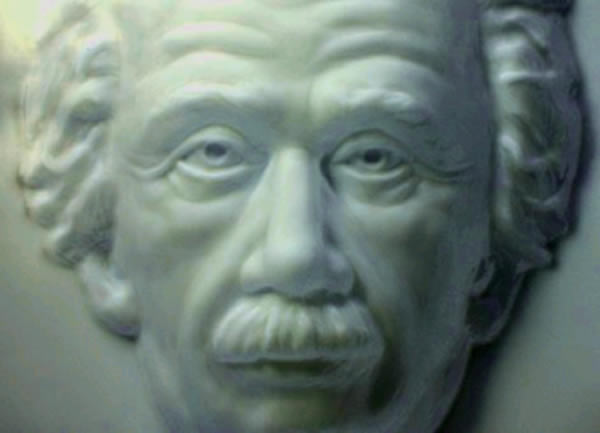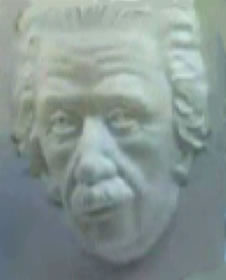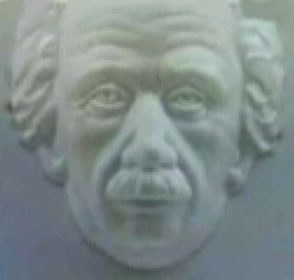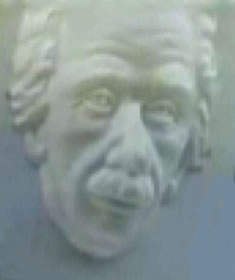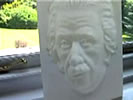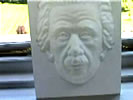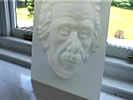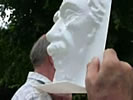Hollow-Face illusion The Hollow-Face
illusion is an optical illusion in which the perception of a concave
mask of a face appears as a normal convex face. This illusion reveals
the significant role of prior experience, and thus hypotheses or
expectations, in the perceptual process. Psychologists and other
scientists have found the hollow face illusion a valuable tool to
examine the relationships between perception and knowledge. |
|
|
This
optical illusion is one of the best and amazing.
Not in vain about it Oxford Professor Richard Dawkins mentions in his
latest book "The God Delusion".
| While a convex face can appear
to look in a single direction, and a flat face such as the Lord Kitchener
Wants You poster can appear to follow the moving viewer, a hollow
face can appear to move its eyes faster than the viewer: looking forward
when the viewer is directly ahead, but looking at an extreme angle
when the viewer is only at a moderate angle. Thus, changing the viewing
angle of a hollow face can dramatically change the apparent orientation
of the face itself. Where a two dimensional figure can appear to follow
the viewers movements, the hollow face actually appears to swivel.
The hollow face illusion works best with monocular vision; filming with a camera or closing one eye to remove stereoscopic depth cues greatly enhances the illusion. Another example of the Hollow-Face illusion is found in a popular folded paper cutout of a dog or dragon. This dragon's head seems to follow the viewer's eyes everywhere (even up or down), when lighting, perspective and/or stereoscopic cues are not strong enough to tell its face is actually hollow. Keen observers will note that the head doesn't actually follow them, but appears to turn twice as fast around its center than they do themselves. |
|
How
does it work?
When
we 'see' something, our view of the world has been processed by our brain.
And our brain 'knows' that a face is convex, not concave, so that is the
way we see it. When we move, the face does not move in the way
that a convex face would move, so our brain comes up with a different
explanation, and we see the face move, following us wherever we go.
| Explanation Human beings have a great amount of bias towards seeing faces as convex. This bias is so strong that it counters competing monocular depth cues such as shading and shadows, as well as considerable stereoscopic depth cues. The effect of the hollow face illusion is the weakest when the face is viewed upside down, and strongest when in the most commonly viewed, right side up orientation. Lighting a concave face from below to reverse the shading cues making them closer to those of a convex face lit from above can reinforce the illusion. Nevertheless, as Gregory has noted, the illusion persists under less than optimal conditions, albeit less strongly, supporting his thesis that "top-down knowledge can dominate bottom-up signals." In other words, that perception involves hypotheses, based on learning and past experience, which allow us to interpret what we see, and these hypotheses can overpower the actual sensory data that are being received, causing erroneous perceptions—illusions. |
|
|||||||||||||||
Einstein Mask sold in the online store Grand Illusions
Example of the rotating mask -> This particular illusion has many applications in the world of art and illusory magic. The astonishing transformations that concave masks appear to go through when rotated (or the viewer moves) provide endless fascination and novelty to the curious. |
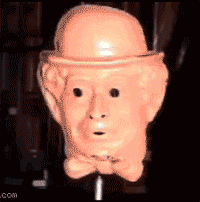 |
| REFERENCES: • Frith, Chris. 2007. Making up the Mind: How the Brain Creates Our Mental World. Blackwell Publishing Ltd. • Gregory, Richard L. 1997. Eye and Brain. Princeton, NJ: Princeton University Press. • Gregory, Richard. 1997. "Knowledge in perception and illusion" Phil. Trans. R. Soc. Lond. B. 352, 1121–1128. Retrieved January 3, 2008. • Hartung, B. Schrater, P. R., H.H Bülthoff, D. Kersten, and V. H Franz. 2005. Is prior knowledge of object geometry used in visually guided reaching? Journal of Vision. 5(6):2. June 10, 2005. 504-514. Retrieved January 3, 2008. • Perlman, M. 2002. Conceptual Flux - Mental Representation, Misrepresentation, and Concept Change. Studies in Cognitive Systems Volume 24. Springer. |
|
|
| Copyright
© 2004 ABC-people.com Design and conception BeStudio © 2016 |
